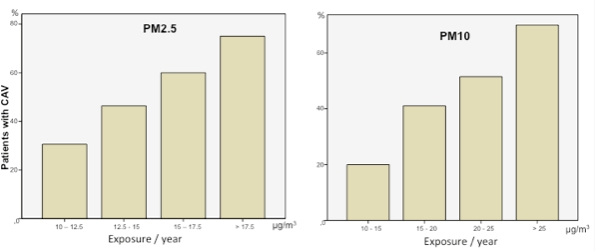Air Pollution Can Support the Development of Cardiac Allograft Vasculopathy
1Cardiothoracic, Transplantation and Vascular Surgery, Hannover Medical School, Hannover, Germany
2Cardiovascular Surgery, University Heart Center, Hamburg, Germany.
Meeting: 2018 American Transplant Congress
Abstract number: B50
Keywords: Graft arterlosclerosis, Heart transplant patients, Rejection, Vascular disease
Session Information
Session Name: Poster Session B: Heart and VADs: All Topics
Session Type: Poster Session
Date: Sunday, June 3, 2018
Session Time: 6:00pm-7:00pm
 Presentation Time: 6:00pm-7:00pm
Presentation Time: 6:00pm-7:00pm
Location: Hall 4EF
Purpose:
Cardiac allograft vasculopathy (CAV) remains one of most important factors leading to graft dysfunction and mortality after heart transplantation (HTx). Thus, the identification of risk factors is of paramount of interest. Recently, studies indicated an association between cardiovascular disorders and air pollution exposure. Thus, in this study we investigated the influence of air pollution on CAV as a risk factor.
Methods
We analysed pooled a total of 165 patientsthat visited out-patient clinics of two transplant centers located in two different areas in Germany; n=72 with angiographic-confirmed CAV (ISHLT 1-3) and n=93 without CAV (ISHLT 0). Based on air pollution data published by the German Environment Office, we estimated the exposure of all patients to particulate matter (PM) of size 2.5[micro]m and 10[micro]m. Cox proportional-hazards regression analyses were performed to identify independent risk factors for reduced freedom from CAV by stepwise backwards and forwards regression analysis (entry: 5%, removal 10%): patient age, post-transplant dialysis, diabetes, insulin, CMV-status of recipient and donor, CMV infection post HTx, acute rejection, arterial hypertension, PM sized 2.5[micro]m of at least 12.5[micro]g/m[sup3] (PM2.5) and PM sized 10[micro]m of at least 12.5[micro]m/m[sup3] (PM10). A p-value of <0.05 was considered statistically significant.
Results:
The amount of patients suffering from CAV increased with exposure to PM2.5 and to PM10. Backwards regression indicated diabetes (HR=2.576; p=0.014), insulin (HR=0.21; p=0.046) and PM2.5[micro]m (HR=3.293; p=0.014) as independent risk factors for CAV. Forward regression resulted in PM2.5[micro]m as the only independent risk factor (HR=3.598; p=0.007).
Backwards regression indicated diabetes (HR=2.576; p=0.014), insulin (HR=0.21; p=0.046) and PM2.5[micro]m (HR=3.293; p=0.014) as independent risk factors for CAV. Forward regression resulted in PM2.5[micro]m as the only independent risk factor (HR=3.598; p=0.007).
Conclusion:
Air pollution seems to be an additional risk factor supporting development of CAV after HTx. Further investigations are indicated to validate these observations in a larger study population and to identify the underlying pathological mechanisms.
CITATION INFORMATION: Bara C., Barten M., Boethig D., Scheibner Y., Tauber J., Reichenspurner H., Haverich A. Air Pollution Can Support the Development of Cardiac Allograft Vasculopathy Am J Transplant. 2017;17 (suppl 3).
To cite this abstract in AMA style:
Bara C, Barten M, Boethig D, Scheibner Y, Tauber J, Reichenspurner H, Haverich A. Air Pollution Can Support the Development of Cardiac Allograft Vasculopathy [abstract]. https://atcmeetingabstracts.com/abstract/air-pollution-can-support-the-development-of-cardiac-allograft-vasculopathy/. Accessed July 5, 2025.« Back to 2018 American Transplant Congress
